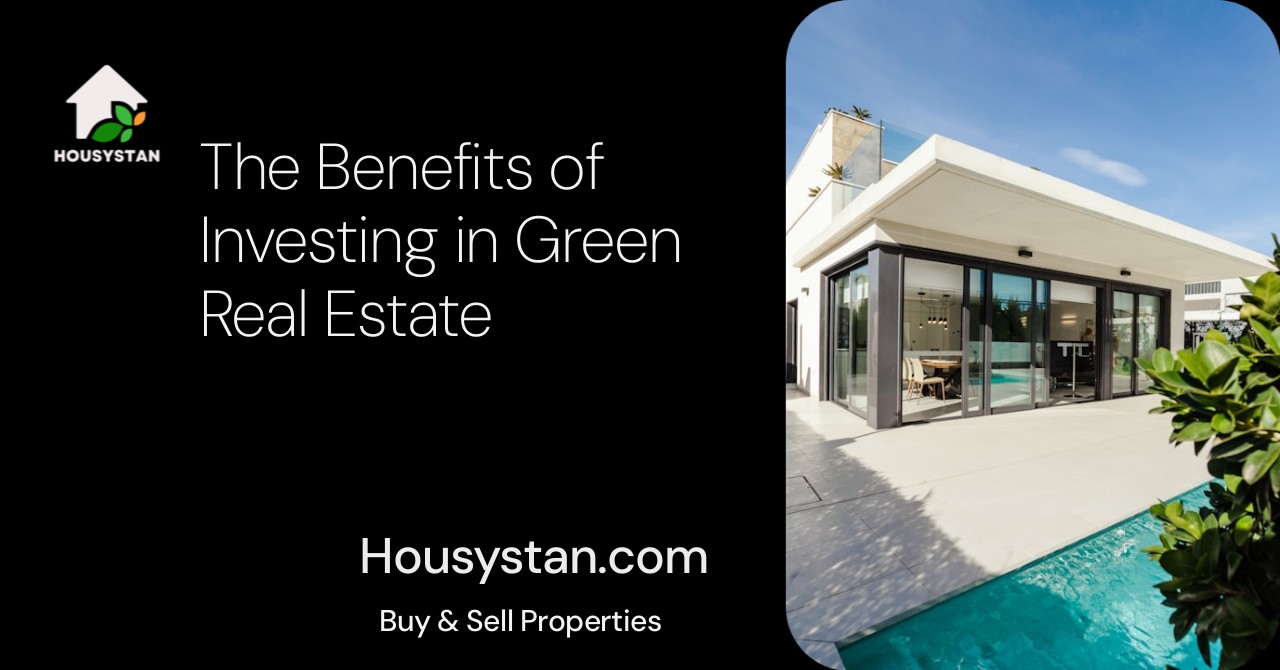The Benefits of Investing in Green Real Estate
Read latest blogs and articles from Housystan

The Information mentioned here was last updated on:
28/12/2025The Benefits of Investing in Green Real Estate
In today's world, sustainability is more than just a buzzword; it is becoming a core consideration in many sectors, including the real estate market. Green real estate, also known as sustainable or eco-friendly real estate, refers to properties designed, built, and maintained with a focus on environmental responsibility and resource efficiency. As awareness continues to grow around the importance of sustainability, more investors are turning to green real estate for its myriad of benefits. This blog post explores these benefits and why investing in green real estate is a smart move for the future.
Why Green Real Estate?
- Verified Tenants/Buyers
- Unlimited Property Listing
- Zero subscription/charges fee
Green real estate offers numerous advantages that are becoming increasingly attractive to investors. From financial benefits to environmental impacts, understanding these key factors provides a clearer picture of why going green is worthwhile.
Financial Incentives
Investing in green real estate can deliver significant financial gains:
- Energy Efficiency: Properties designed for energy efficiency reduce utility costs. Facilities with features like solar panels, advanced insulation, and energy-efficient HVAC systems often see lower energy bills, which translates to long-term savings for owners.
- Increased Property Value: Sustainable buildings are often more attractive to buyers and renters, leading to higher property values. They are seen as modern, forward-thinking investments, which can command premium prices.
- Tax Incentives and Rebates: Many governments offer financial incentives for building or renovating properties to be more eco-friendly. These can include tax credits, rebates, or grants aimed at reducing the overall cost of adopting sustainable practices.
Market Demand
As sustainability becomes a priority, the demand for green real estate is on the rise:
- Tenant Attraction and Retention: Eco-friendly buildings tend to attract high-quality tenants willing to pay premium rents. Features like good indoor air quality, natural lighting, and sustainable building materials are appealing and can lead to higher tenant retention rates.
- Competitive Edge: Having a green-certified building gives properties a competitive edge in the real estate market. With many companies striving to meet their sustainability goals, such buildings become a sought-after commodity.
Environmental Benefits
Green real estate boasts numerous environmental benefits, making it appealing to environmentally-conscious investors:
- Reduction in Carbon Footprint: Sustainable buildings are designed to minimize energy consumption and reduce greenhouse gas emissions. This plays a key role in combating climate change, aligning with global priorities.
- Conservation of Natural Resources: Green buildings often use renewable resources wisely, incorporating sustainable materials like recycled steel or reclaimed wood, which greatly reduces their environmental impact.
Key Features of Green Real Estate
Understanding what makes a property green is crucial for investors looking to enter this sector. Here are some key features typically found in green real estate:
Energy Systems
- Photovoltaic Solar Panels: These panels convert sunlight into electricity, reducing dependency on non-renewable energy sources.
- Geothermal Heating and Cooling: Utilizes the earth’s natural heat to provide efficient heating and cooling solutions.
- LED Lighting and Smart Systems: Optimizes lighting efficiency and reduces wastage with programmable systems.
Water Management
- Rainwater Harvesting Systems: Collects rainwater for irrigation and other non-potable uses, helping reduce water consumption.
- Low-Flow Fixtures: These include toilets, taps, and showerheads designed to use less water without sacrificing performance.
Sustainable Materials
- Environmentally Preferable Products: Materials that reduce environmental impact, such as rapidly renewable or recycled contents.
- Low-VOC Paints and Finishes: Improves indoor air quality by reducing volatile organic compounds and harmful emissions.
The Role of Green Certifications
Green certifications play an instrumental role in green real estate, providing assurance and credibility:
- LEED (Leadership in Energy and Environmental Design): One of the most recognized green building certification programs globally. Achieving LEED certification enhances a property’s market profile and demonstrates commitment to sustainability.
- BREEAM (Building Research Establishment Environmental Assessment Method): Popular in Europe, this certification encourages designers and builders to consider environmental impact at every stage.
- Energy Star: U.S.-based certification for energy-efficient buildings, indicating superior energy performance.
How to Start Investing in Green Real Estate
For those interested in diving into green real estate, here are steps that can help:
Research and Education
- Stay Informed: Keep up with market trends, government incentives, and new green technologies through credible sources and industry reports.
- Participate in Workshops: Engage in seminars or workshops on sustainable building and investment strategies to expand your knowledge base.
Collaborate with Green Experts
- Consult Green Architects and Builders: Work with professionals experienced in sustainable design and construction.
- Hire Sustainability Consultants: These experts can guide the certification process and help identify areas for improvement.
Evaluate Potential Investments
- Assess the Location: Choose locations where sustainability is a valued community priority, which can enhance the property's desirability.
- Verify Certifications: Ensure any prospective investment has the desired green certifications or potential to achieve them.
Internal Links Suggestion
While focusing on green real estate, readers might be interested in exploring [emerging real estate trends](), [energy-saving home improvements](), and [tax benefits for eco-friendly investments](). These topics further delve into how broader real estate practices intersect with sustainability, offering more comprehensive insights into the field.
Keeping Up With the Future